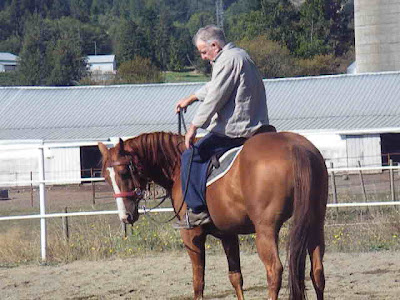One thing you can work on on a rainy day is having your horse bend from a touch on his side. Specifically you want to go to the end of the withers and then drop straight down to about his elbow height and apply pressure. What you're trying to do is trigger the nerve ending that will cause a muscle contraction at his point of oscillation ( right behind the withers) thereby bending the horse at his middle.
I like to touch as light as a fly and release as soon as the horse starts to bring his head towards you at all, even a whisker. Then touch again and release as he tries. Some horses require a "big fly". I always have a hoof pick in my pocket when I start and then if the fly touch needs to be increased and my thumb is not enough I can add the point of the hoof pick, like a spur. Once I apply pressure I do not release until I get a try, then release immediately.
If the horse moves I try to stop him but do not release the pressure unless I see a bend. If the horse tries to bite or kick you discipline as necessary but keep asking. Most horses will get nice and light fairly fast. If I want to build this in to leg yield or circling I will click but if I don't click he shouldn't move.
One thing you should check is how you're standing when you ask for this. I like to face the shoulder so the horse knows to stand still, keep your weight more on the foot that's furthest from his head and keep your hip pulled away. In this manner you won't be blocking what you're asking for.
One thing you should check is how you're standing when you ask for this. I like to face the shoulder so the horse knows to stand still, keep your weight more on the foot that's furthest from his head and keep your hip pulled away. In this manner you won't be blocking what you're asking for.
You can practice this first on his good side to get an idea of how it works then work on the bad side. I was working a new horse one day that would run away and not bend while two trainers at the rail talked about all the reasons why he might be doing this, including him not being able to bend well. 15 minutes later I had this horse bending around to his girth on both sides. This ruled out the question of whether he couldn't bend as well as teaching him how to respond to my leg.
When he's light you can saddle up and repeat this on the ground to rule out saddle interference, then get on and sitting in one place bend him from side to side with your legs. When you ask him to move have him already bent with your legs and see if he'll move off without straightening or dropping in, if he does use your spur if necessary as you used the hoofpick to get him to yield his ribs.
This exercise can be used to develop respect and focus by insisting the horse always maintain a slight bend of the ribs away from you when on the ground. A horse that bends in to you is in a power position, ready to push you out of the way. Not only does maintaining true bend teach a horse to stay focused on you it also teaches him that you're aware every time he loses focus or bends in to you. Proving your awareness makes you a better leader and develops the horses trust that if you are that aware, you may just see the cougar lurking in the bushes.
Now our horse is supple, light, respectful, focused and trusting. Not bad for one little exercise


So what kind of discipline is necessary if my horse tosses his head all over or tries to bite me when I ask him to do this? He will only yield to his right and backwards. When I ask for anything else, he tries to bite my hand or throws his head all over.
ReplyDeleteMost important is to make sure your body is not being rude by being out of position and having pressure on his head.
ReplyDeleteSecond if a horse is still being aggressive put him to work. Block the head from coming at you while sending the horse foreward and around you, looking for a change. Then stop and try again. Be persistent with letting him know he's wrong by sending him away and consistent with letting him know he's right by rewarding the slightest try. Good luck, hope this helps.
Also see Wednesday, January 19, 2011
ReplyDeleteThe Biting Horse as a follow up.